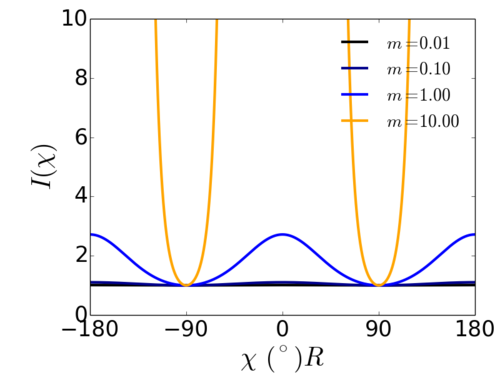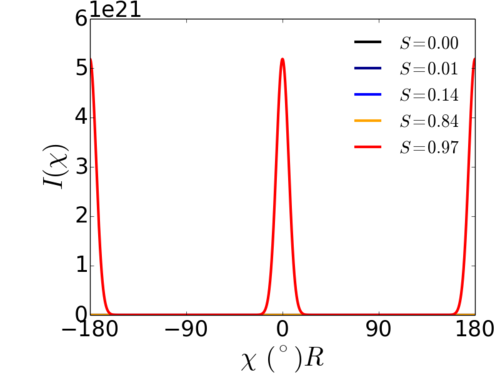Difference between revisions of "Circular orientation distribution function"
KevinYager (talk | contribs) |
KevinYager (talk | contribs) |
||
| Line 1: | Line 1: | ||
| − | In assessing the orientation of aligned materials, one can use the [[orientation order parameter]] to quantify order. Another possibility is to fit [[scattering]] data using an equation that has 'circular wrapping' (i.e. periodic along <math>\scriptstyle 2 \pi</math>). Ruland ''et al.'' present such an equation: | + | In assessing the orientation of aligned materials, one can use the [[orientation order parameter]] to quantify order. Another possibility is to fit [[scattering]] data using an equation that has 'circular wrapping' (i.e. periodic along <math>\scriptstyle 2 \pi</math>). |
| + | |||
| + | =<math>\scriptstyle \eta </math> function= | ||
| + | Ruland ''et al.'' present such an equation: | ||
:<math> | :<math> | ||
| Line 9: | Line 12: | ||
[[Image:Eta func-I chi.png|500px]] | [[Image:Eta func-I chi.png|500px]] | ||
| − | + | ==References== | |
| − | == | ||
* Ruland, W.; Tompa, H., The Effect of Preferred Orientation on the Intensity Distribution of (Hk) Interferences. Acta Crystallographica Section A 1968, 24, 93-99. | * Ruland, W.; Tompa, H., The Effect of Preferred Orientation on the Intensity Distribution of (Hk) Interferences. Acta Crystallographica Section A 1968, 24, 93-99. | ||
* Ruland, W.; Smarsly, B., Saxs of Self-Assembled Oriented Lamellar Nanocomposite Films: An Advanced Method of Evaluation. J. Appl. Crystallogr. 2004, 37, 575-584. | * Ruland, W.; Smarsly, B., Saxs of Self-Assembled Oriented Lamellar Nanocomposite Films: An Advanced Method of Evaluation. J. Appl. Crystallogr. 2004, 37, 575-584. | ||
| + | |||
| + | =Maier-Saupe distribution parameter= | ||
| + | |||
| + | :<math> | ||
| + | I(\chi) = \frac{1}{c} \exp \left [ m \cos ^2 \chi \right ] | ||
| + | </math> | ||
| + | |||
| + | Where <math>\scriptstyle m</math> is a parameter that can be related to the [[orientation order parameter|order parameter]] <math>\scriptstyle S</math>; specifically <math>\scriptstyle m =0 </math> is for an isotropic distribution (<math>\scriptstyle S = 0</math>), while <math>\scriptstyle m \to \infty</math> is for a well-aligned system (<math>\scriptstyle S \to 1</math>). | ||
| + | |||
| + | [[Image:MaierSaupe-ODF-01.png|500px]] | ||
| + | [[Image:MaierSaupe-ODF-021.png|500px]] | ||
| + | |||
| + | |||
| + | ==References== | ||
| + | * B. J. Lemaire, P. Panine, J. C. P. Gabriel and P. Davidson [http://iopscience.iop.org/article/10.1209/epl/i2002-00159-8/meta The measurement by SAXS of the nematic order parameter of laponite gels] ''Europhysics Letters'' '''2002''', 59 (1), 55-61. | ||
| + | * Maier W. and Saupe A., Z. Naturforsch. A, 13 ([http://www.znaturforsch.com/aa/v13a/c13a.htm 1958]) [http://zfn.mpdl.mpg.de/data/Reihe_A/13/ZNA-1958-13a-0564_n.pdf 564]; 14 ([http://www.znaturforsch.com/aa/v14a/c14a.htm 1959]) [http://zfn.mpdl.mpg.de/data/Reihe_A/14/ZNA-1959-14a-0882.pdf 882]; 15 ([http://www.znaturforsch.com/aa/v15a/c15a.htm 1960]) [http://zfn.mpdl.mpg.de/data/Reihe_A/15/ZNA-1960-15a-0287.pdf 287]. | ||
Revision as of 15:33, 21 December 2015
In assessing the orientation of aligned materials, one can use the orientation order parameter to quantify order. Another possibility is to fit scattering data using an equation that has 'circular wrapping' (i.e. periodic along ).
function
Ruland et al. present such an equation:
Where is the angle along the arc of the scattering ring/feature. The single fit parameter () is convenient in that it behaves in a similar way to an order parameter: a value close to 1.0 indicates strong alignment, while progressively smaller values indicate lesser alignment. For a random sample, the scattering is isotropic and .
References
- Ruland, W.; Tompa, H., The Effect of Preferred Orientation on the Intensity Distribution of (Hk) Interferences. Acta Crystallographica Section A 1968, 24, 93-99.
- Ruland, W.; Smarsly, B., Saxs of Self-Assembled Oriented Lamellar Nanocomposite Films: An Advanced Method of Evaluation. J. Appl. Crystallogr. 2004, 37, 575-584.
Maier-Saupe distribution parameter
Where is a parameter that can be related to the order parameter ; specifically is for an isotropic distribution (), while is for a well-aligned system ().






![{\displaystyle I(\chi )={\frac {1}{c}}\exp \left[m\cos ^{2}\chi \right]}](https://wikimedia.org/api/rest_v1/media/math/render/svg/49bde8b233a0c9f4c7f1b73ce1fd95128a73bb00)







